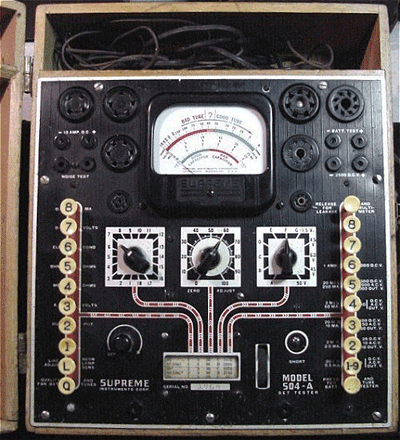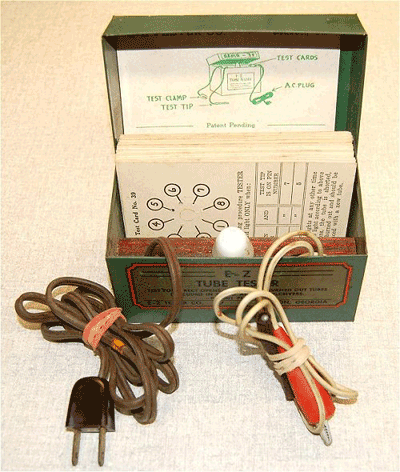What’s It Worth: Simple vacuum tube testers
BY STEVE JOHNSON
There is nothing simple about a good vacuum tube tester. In fact, most tube testers were very complicated to set up for each different type of tube to be tested. Testing a quantity of different tubes required a great deal of setup time. The higher the number of dials and switches that needed to be set for a particular tube, the greater the risk of the technician making mistakes during this setup process. Over the years, test equipment manufacturers tried various ways to make the test setup quicker, simpler, and almost foolproof.
Popular tube testers built in the 1960s usually had at least ten rotary switches and two dials that needed to be set for each different type of tube to be tested. This frequently lead to set up errors which either gave a false reading of a tube’s condition or worse yet, ruined a perfectly good tube. This number of settings was typical of quality tube testers manufactured from the 1950s through the 1960s. There was an advantage though to having a tube tester with controls for setting all the various tube voltages and parameters needed. As additional new tubes were introduced, updated tube setting charts could easily be provided with no need for electrical modifications to the tube tester.

This early Supreme Instruments model 17 tube tester had no controls or switches to set.
There have been several attempts to design a tester that would eliminate setup errors. Tube testers of the late 1920s and early 30s did not have to test very many tubes. In fact, some early tube testers actually had all the tube numbers they tested stamped next to the appropriate tube socket. The supreme model 17 tube tester shown above was manufactured in the late 1920s and tested the 16 most common tubes at the time. The model 17 listed the tube number next to the appropriate test socket along with the bias and milliamp readings expected on the meter when the tube was inserted into the socket. All a technician had to do was insert the tube in the proper socket, push a button, and compare the reading on the meter to the values listed next to the tube number on the face of the tester.
These early tube testers tested so few tubes that they are not usable today. However, they are very collectible and may bring up to $150 at auction depending manufacturer, model, and condition.

This confidence special tube tester used one rotary dial with 56 positions.
In the 1930s, the Apparatus Design Company of Little Rock Arkansas manufactured a “Confidence” model tube tester that utilized a simple system of eight numbered tube sockets and one large rotary dial that could be pointed to any one of 56 positions. The service technician would find the tube on the included chart which gave him the socket number to insert the tube into and the position of the dial for testing. Unfortunately within just a few short years there were so many additional tubes, the Confidence tube tester which was not upgradeable, was rendered obsolete. Thousands of these testers were manufactured and are still fairly common today in collector circles. Most will sell today for less than $100.

This Supreme Instruments tube tester had lines on its face to guide the technician to the appropriate set of pushbutton’s or switches.
During the 1940s, Supreme Instruments manufactured a series of pushbutton tube testers that had lines painted on the face running from the column on the roll chart that listed the settings of the tube, to the appropriate set of pushbuttons or dial that the technician to set. This was thought to reduce the chance of setup mistakes. Supreme continued to utilize these graphics on many of their tube testers well into the 1950s. Today these testers in working condition sell in the $50 to $100 range.
In the 1950s, tube testers appeared in grocery stores and corner drugstores. It was imperative that these self-test tube testers were easy for anyone to use. These testers were designed with as few switches and buttons as possible so that the public could easily operate them. It was not uncommon to find one of these tube testers with over 50 separate numbered tube sockets. The customer would look up the tube number on the chart and place a tube in the numbered socket listed on the chart and press one button to perform the test. Although these testers only gave a basic indication if the tube was operational or not, they were easy to use and allowed an untrained store clerk to sell vacuum tubes. Many of these drugstore tube testers still exist today in collections. Unfortunately due to their size and cost of shipping, these testers usually sell for under $150. More often than not, they are purchased for their built-in electric signage listing a particular brand of tube.
In the 1950s and early 1960s, simple tube testers were sold in hardware stores and drugstores for home use. These small tube testers were battery-powered and performed only the very basic test of checking to see if the tube filament was good. Most were battery-powered and used a small lamp to indicate if the filament had continuity. These handheld testers have little to no value today even to a collector.

This E-Z Tube Tester tested tube filaments by applying 110 Vac.
The most dangerous of these home tube testers I have seen is the E-Z Tube Tester. The E-Z Tube Tester was manufactured by the E-Z Tester Co., in Macon, GA. This 1952-era tube tester was made from a standard 3 x 5 file card box and a piece of wood with a nightlight lamp mounted in it. It came with 39 test cards. You would place the tube pins through the proper card and use the test leads across the pins noted on the card to check the tubes filament and for shorts. The test leads you held in your hand applied 110 volts directly to the pins on the tube. If you didn’t electrocute yourself first, there was a good chance the ac supplied by the tube tester would destroy the tube you were testing. If you were successful at touching the leads to the correct pins, the lamp lit indicating the tube filament was good. And original E-Z Tube Tester is only a conversation piece today and would probably not have much value.

The Hickok 121 “Cardmatic” Tube Tester
Finally, in the late 1950s, the Hickok Electrical Instrument Co. designed a professional tube tester that was capable of testing hundreds of different vacuum tubes and eliminated setting switches and dials altogether, avoiding setup mistakes. These unique tube testers also used punch cards. Hickok called their new line of punch card testers “Cardmaitc” Tube Testers. The Cardmatic tube tester came with set of cards for testing over 300 tubes. Several hundred additional cards were available along with a kit to make your own cards for tubes not included in the original set, and cards to calibrate the tube tester.
To test a tube on the Cardmatic, the technician would take the appropriate punched card for the tube they wanted to test and inserted it into a slot on the tube tester. He would then push a plunger on the top of the tester that would mechanically push pins through the empty holes on the card, which automatically set up the tester for testing that particular tube. If a tube had more than one section to test a different card was provided to test each section. Today the Hickok Cardmatic tube testers are sought after by both technicians and collectors. It is not uncommon to see a working military version of these testers sell for over $1,000. Any Hickok Cardmatic series tube tester in good working and cosmetic condition will usually sell for several hundred dollars.
For more information about the vintage equipment discussed here, view my collection at StevesAntiqueTechnology.com. ■
Advertisement
Learn more about Electronic Products Magazine





